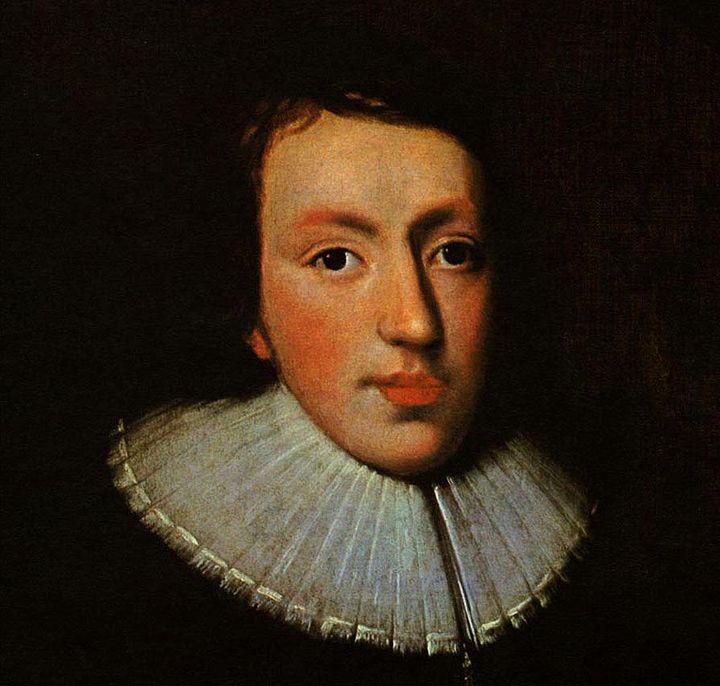He was the son of a wealthy iron merchant, born in London in 1572. He came from a very influential family background. On his father’s side he came from an old Welsh family and on his mother’s side from the Heywoods and Sir Thomas More’s family. He was educated at his home till he was eleven, and later sent to Oxford, and at fourteen to Cambridge. But he could not continue his education due to his family’s inclination towards Romantic Catholicism. While he was studying law at Lincoln’s Inn, he gave up his Catholicism and called himself simply Christian. He travelled to Rome and Italy and upon his return to England was appointed secretary to the Earl of Ellesmere. His career was terminated when he fell in love and married the Earl’s young niece, Anne More. After years of poverty and hardships, the young lovers were forgiven by Sir George More. He also presented his daughter with an allowance of £800. With his “Pseudo Martyr” he gained the favour of James I and in 1619, he was sent on a diplomatic mission to Germany with Lord Doncaster. Later he was appointed as Dean of St. Paul’s Cathedral in London and reached his peak of popularity. He died in 1631 at Essex and is buried in St. Paul’s Cathedral.
Donne’s poetry is categorised as Metaphysical Poetry. A school of poetry according to Dryden which “affects the metaphysics, not only in his satires, but in his amorous verses, where nature only should reign; and perplexes the mind the minds of the fair sex with nice speculations of philosophy, when he should engage their hearts, and entertain them with the softness of love.” His poetry is witty and engages the reader’s intellectually. His knowledge and learning are reflected in his poems through his abundant use on ‘conceits’.
The poem “A Valediction of Weeping” was most probably written by Donne after he met Anne More. There are subtle hints which could make us assume that the poem is autobiographical. But one could not be so sure when it comes to Donne’s poetry. Certainly, he has used autobiographical elements, but they are very cunningly and wittily enclosed within the veils of wit and imagination.
Theme:
The theme of the poem is the departure of the poet for a voyage. The poem expresses intense misery on part of the lovers caused by the parting.
Summary and analysis:
The poem denotes the grief of separation. The poet is about to go on a voyage and he is trying to console his beloved. He consoles her by saying that she should not weep, as her sighs will result in the death of other. He asks her to be calm so that he can have a safe voyage and return safely.
The first stanza begins with the lover’s proclamation of sorrow towards his beloved:
Let me pour forth
My tears before thy face, whilst I stay here,
For thy face coins them, and thy stamp they bear,
And by this mintage they are something worth,
For thus they be
Pregnant of thee;
Fruits of much grief they are, emblems of more,
When a tear falls, that thou falls which it bore,
So thou and I are nothing then, when on a diverse shore.
In the above lines the poet is not asking for any physical connection with his beloved, instead he seeks to reflect and be reflected by his beloved—implying the concept of being inseparable. He appears to be saying that the tears if they fall will be rendered useless and hence by the reference to ‘coins’ and ‘stamp’ he might be indicating that by procuring them he could keep her happy. Hence, his voyage is unavoidable. There is conceit in the line “Fruits of much grief they are, emblems of more”; the tears are being compared to fruits which will bring no happiness, and will only ripen into sorrows. In the last two lines of the stanza, the conceit is implied between the beloved’s tears and the sea water. As both the tears and the sea water are salty in nature, her tears symbolically refer to the impending separation between them. In these two lines there is a reference to ‘fall’ the ‘fall’ might imply two things, that when her tears fall, he is separated from her and also upon his leaving she might ‘fall’, i.e., become unfaithful. In a very apprehensive tone he appears to be implying that when set apart on “diverse shores” they will mean nothing.
The next stanza introduces a new metaphor:
On a round ball
A workman that hath copies by, can lay
An Europe, Africa, and an Asia,
And quickly make that, which was nothing, all;
So doth each tear
Which thee doth wear,A globe, yea world, by that impression grow,
Till thy tears mix’d with mine do overflow
This world; by waters sent from thee, my heaven dissolved so.
The poet brings in the concept that like all the continents are put together by a workman to create a perfect globe, the lovers together form a perfect conjugal globe. “The poem uses the figure of a world contained in a reflection, and in each case great stress is put on the metaphysical nature of that containment: the physical object is captured in a reflection, but so is the object’s essence.” Just like a sphere is empty without the maps, and becomes “all” only after the maps are engraved upon it; in a similar manner, the tears also become “all” only when the lover’s face is reflected in it. In the last two lines:
Till thy tears mix’d with mine do overflow
This world; by waters sent from thee, my heaven dissolved so.
The poet implies that through their tears the lovers are continuously building and destroying their world. That is to imply a continuous process of endless creation and endless destruction.
Just after this the poet compares the beloved to the moon, the source of energy which controls the tidal waves:
O more than moon,
Draw not up seas to drown me in thy sphere,
Weep me not dead, in thine arms, but forbear
To teach the sea what it may do too soon;
Let not the wind
Example find,
To do me more harm than it purposeth;
Since thou and I sigh one another’s breath,
Whoe’er sighs most is cruellest, and hastes the other’s death.
She is described as being “more than moon”, and thus possesses more power over the waves. The poet tells her that if she keeps on weeping, the sphere which comprises of him also will be drowned in her tears as he is a part of her and vice versa. He requests her not to drown him in her tears and give the sea its lease to wreck havoc upon him and also give the wind an example. Thus he implies that her bewailing will only bring death closer to him and take him away from her.
The last two lines present a paradox:
Since thou and I sigh one another’s breath,
Whoe’er sighs most is cruellest, and hastes the other’s death.
Breathing which is considered a source of life becomes a source of death, when it comes in the form of sighs from the lover. Thus, like the metaphor of tears drowning his reflection, her sighs appear to be taking away his life-breath.
Like most of Donne’s metaphysical poems, this too plays around with different variations of conceits; complicated metaphors are drawn in to bring in symbolic implications of the emotional harm brought upon by the tears. The tone of the poem is colloquial and appears to be conversational, as if a silent listener is present before the poet.
Though the poet does not use any sexual imagery in the poem but the importance of being united in soul is established throughout the poem. According to Empson the poem was written during his first voyage with Essex, which he said he undertook to escape from “the queasy pain of loving and being loved”.
Works Cited:
Alexander, Michael. A History of English Literature. 2nd ed. Palgrave Foundations.
Compton-Rickett, Arthur. A History of English Literature. UBSPD, New Delhi. 2010.
Long, Wiliam J. English Literature. Indian Books View, Kolkata. 2009.
“A Valediction: Of Weeping”. http://www.poetryfoundation.org/learning/guide/245494
Some online learning platforms provide certifications, while others are designed to simply grow your skills in your personal and professional life. Including Masterclass and Coursera, here are our recommendations for the best online learning platforms you can sign up for today.
The 7 Best Online Learning Platforms of 2022
- Best Overall: Coursera
- Best for Niche Topics: Udemy
- Best for Creative Fields: Skillshare
- Best for Celebrity Lessons: MasterClass
- Best for STEM: EdX
- Best for Career Building: Udacity
- Best for Data Learning: Pluralsight














Nice notes ,it is very easy to understand thanks